Multimedia Gallery
Electrons and holes condense into liquid droplets
Electrons (blue) and holes (red) condense into liquid droplets akin to liquid water in devices composed of ultrathin materials. Researchers bombarded an ultrathin semiconductor sandwich with powerful laser pulses to create the first "electron liquid" at room temperature.
[Research supported by National Science Foundation grants DMR 1651247 and DMR 1506707.]
Learn more about this research in the University of California, Riverside, news story UC Riverside physicists create exotic electron liquid. (Date image taken: unknown; date originally posted to NSF Multimedia Gallery: Dec. 27, 2019)
Credit: University of California, Riverside
Images and other media in the National Science Foundation Multimedia Gallery are available for use in print and electronic material by NSF employees, members of the media, university staff, teachers and the general public. All media in the gallery are intended for personal, educational and nonprofit/non-commercial use only.
Images credited to the National Science Foundation, a federal agency, are in the public domain. The images were created by employees of the United States Government as part of their official duties or prepared by contractors as "works for hire" for NSF. You may freely use NSF-credited images and, at your discretion, credit NSF with a "Courtesy: National Science Foundation" notation.
Additional information about general usage can be found in Conditions.
Also Available:
Download the high-resolution JPG version of the image. (728.5 KB)
Use your mouse to right-click (Mac users may need to Ctrl-click) the link above and choose the option that will save the file or target to your computer.



 All images in this series
All images in this series